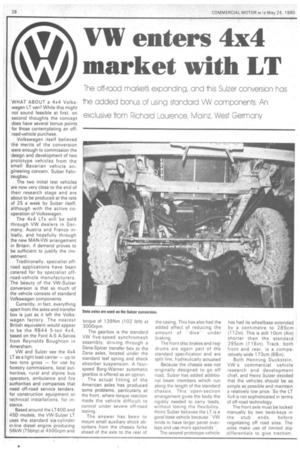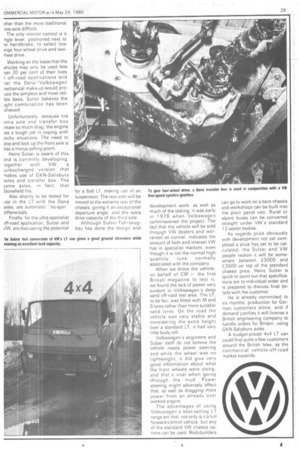VW enters 4x4 market with LT
Page 30

Page 31

If you've noticed an error in this article please click here to report it so we can fix it.
The off-raod market expanding, and this Sulzer conversion has the added bonus of using standard VW components. An exclusive from Richard Laurence, Mainz, West Germany
WHAT ABOUT a 4x4 Volkswagen LT van? While this might not sound feasible at first, on second thoughts the concept does have several bonus points for those contemplating an offroad-vehicle purchase.
-Volkswagen itself believed the merits of the conversion were enough to commission the design and development of two prototype vehicles from the small Bavarian vehicle engineering concern. Sulzer Fahrzeugbau.
The two initial test vehicles are now very close to the end of their research stage and are about to be produced at the rate of 25 a week by Sulzer itself, although with the active cooperation of Volkswagen.
The 4x4 LTs will be sold through VW dealers in Germany, Austria and France initially, and hopefully through the new MAN-VW arrangement in Britain, if demand proves to be sufficient to justify the investment.
• Traditionally, specialist offroad applications have been catered for by specialist offroad-vehicle manufacturers. The beauty of the VW-Sulzer conversion is that so much of the vehicle consists of standard Volkswagen components.
Currently, in fact, everything apart from the axles and transfer box is just as it left the Volkswagen factory. The nearest British equivalent would appear to be the RB44 5-ton 4x4, based on the Ford A-S A-Series from Reynolds Boughton in Amersham.
VW and Sulzer see the 4x4 LT as a light load carrier — up to two tons gross — for use by forestry commissions, local authorities, rural and alpine bus operators, ambulance and fire authorities and companies that need off-road service tenders: for construction equipment or technical installations, for instance.
Based around the LT4OD and 45D models, the VW-Sulzer LT uses the standard six-cylinder in-line diesel engine producing 56kW (75bhp) at 4500rpm and torque of 139Nm (102 lbft) at 300Orpm.
The gearbox is the standard VW five-speed synchromesh assembly, driving through a Dana-Spicer transfer box to the Dana axles, located under the standard leaf spring and shock absorber suspension. A fourspeed Borg-Warner automatic gearbox is offered as an option.
The actual fitting of the. American axles has produced some problems, particularly at the front, where torque reaction made the vehicle difficult to control under severe off-road testing
The answer has been to mount small auxiliary shock absorbers from the chassis forks ahead of the axle to the rear of the casing. This has also had the added effect of reducing the amount of "dive" under braking.
The front disc brakes and reef drums are again part of the standard specification and are split line, hydraulically actuated
Because the chassis was not .originally designed to go off road, Sulzer has added additional beam members which run along the length of the standard chassis. This open-section arrangement gives the body the rigidity needed to carry loads, without losing the flexibility. Heinz Sulzer believes the LT is a good base vehicle because -VW tends to have larger panel overlaps and use more spotwelds-.
The second prototype vehicle has had its wheelbase extended by a centimetre to 285cm (112in). This is still 10cm (4in) shorter than the standard 295cm (116in). Track, both front and rear, is a corn paratively wide 173cm (68in).
Both Henning Duckstein, VW's commercial vehicle research and development chief, and Heinz Sulzer decided that the vehicles should be as simple as possible and maintain a relatively low price. So the LT 4x4 is not sophisticated in terms of off-road technology.
The front axle must be locked manually by two twist-keys in the stub ends, before negotiating off road sites. The axles make use of limited slip differentials to give traction,
ither than the more traditional -oss-axle difflock.
The only interior control is a ngle lever, positioned next to le handbrake, to select low Inge four-wheel drive and two'heel drive.
Working onthe basis that the ehicles may only be used less an 20 per cent of their lives off-road applications and let the Dana /Volkswagen lechanical make-up would prouce the simplest and most relible basis, Sulzer believes the ight combination has been chieved.
Unfortunately, because toe xtra axle and transfer box :reate so much drag, the engine as a tough job in coping with ;ticky situations. The need to ;top and lock up the front axle is 3Is0 a minus selling-point.
Heinz Sulzer is aware of this 3 n d is currently developing, together with VW, a turbocharged version that makes use of GKN-Salisbury axles and transfer box. The same axles, in fact, that Stonefield fits.
Also shortly to be tested for use in the LT with the Dana axles, are automatic -no-spiniifferentials.
Finally, for the ultra-specialist 3ff-road application, Sulzer and VW, are discussing the potential for a 6x6 LT, making use of air suspension. The rear axle will be moved to the extreme rear of the chassis, giving it an exceptional departure angle, and the extra drive capacity of the third axle.
Although Sulzer Fahrzeugbau has done the design and development work, as well as much of the testing, it was early in 1978 when Volkswagen commissioned the project. The fact that the vehicle will be sold through VW dealers and warranted as normal, indicates the amount of faith and interest VW has in specialist markets, even though it is not the normal high quantity runs normally associated with the company.
When we drove the vehicle, on behalf of CM — the first British magazine to test it, we found the lack of power very evident in Volkswagen's deep sand off-road test area. The LT, to be fair, was fitted with M and S tyres rather than more suitable sand tyres. On the road the vehicle was very stable and considering the extra height over a standard LT, it had very little body roll.
Volkswagen's engineers and Sulzer itself do not believe the vehicle needs power steering and while the wheel was no lightweight, it did give very good information about what the front wheels were doing, and that's vital when going through the mud. Power steering might adversely affect that, as well as dragging more power from an already over worked engine.
The advantages of using Volkswagen's best-selling LT range are that, not only is it a full forward-control vehicle, but any of the standard VW chassis options can be used. Bodybuilders can go to work on a bare chassis and workshops can be built into the plain panel van. Rural or alpine buses can be converted straight under VW's standard 12-seater bodies.
As regards price obviously with development not yet completed a price has yet.to be calculated, the Sulzer and VW people reckon it will be somewhere between £3000 and E3500 on top of the standard chassis price. Heinz Sulzer is quick to point out that specifications are to individual order and is prepared to discuss final details with the customer.
He is already committed to six months' production for German customers alone, and if demand justifies it will license a British engineering company to handle orders for Britain, using GKN-Salisbury axles.
A budget-priced 4x4 LT van could find quite a few customers around the British Isles, as the commercial vehicle-off-road market expands.
































































































































